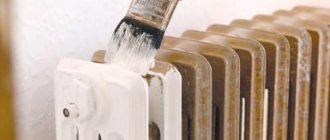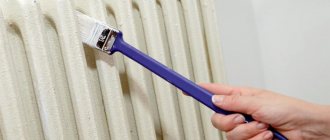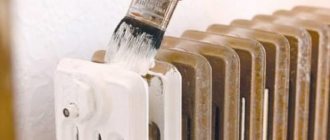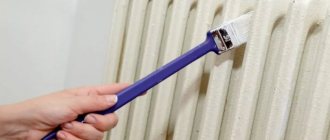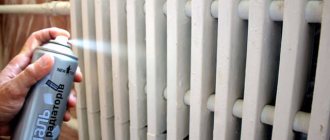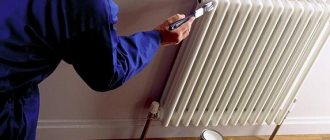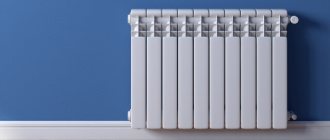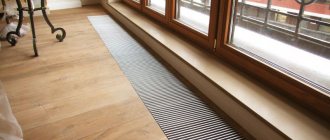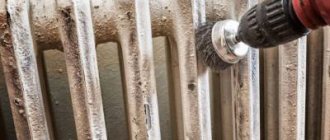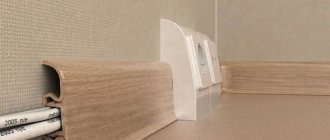City apartment owners are accustomed to carrying out spot repairs in the winter. Indeed, the majority of our citizens spend their free time in spring, summer and autumn at their dachas and suburban areas, go to the sea and to other countries, and therefore the opportunity to update the interior most often appears only in winter. When performing standard work of painting the ceiling or wallpapering the walls, problems usually do not arise, but not many people know whether it is possible to paint hot radiators.
It should be noted that the need to renew the paintwork of water heating radiators arises with each repair. Under the influence of heat, when the heating season begins, the paint loses its former shine and original shade. The effect of temperature is especially noticeable on a white surface, which very quickly becomes yellowish.
To obtain high-quality painting, it is advisable to dismantle the heating radiator, carefully remove the old coating and apply two layers of enamel or other suitable paint. But during the period when the heating is turned on, it is impossible to dismantle the battery (or rather, it is possible, but very difficult), so you have to paint it on site.
Is it possible to paint the battery during the heating season? It is undesirable to apply paint to hot metal surfaces, since the coating dries very quickly on the base, preventing the formation of an even and smooth film, but if the heating system in the room allows you to shut off the coolant, the quality of the paint will be decent.
Otherwise, you will have to apply a coating to the hot surface of the battery, which implies a more careful approach to the selection of material and painting technology.
How to paint a battery
Specially selected paint for hot radiators will help eliminate intoxication of residents and ensure long service life of the radiator.
Most paints normally tolerate the temperatures to which the radiator heats up.
It is important to understand here that the paint coating must also protect the metal from corrosion and not lose color brightness over time. You should choose from the following options:
- Acrylic water-dispersion paint - dries quickly, does not emit an unpleasant odor when heated, has a bright color that lasts a very long time even when exposed to direct sunlight;
- Alkyd paint - withstands temperatures up to 90°C, adheres well to the surface, but is not durable, and when applied it emits a strong, unpleasant odor.
- Acrylic paint with solvent - the surface does not need to be primed to apply it, and the paint itself is not afraid of high temperatures and moisture. A distinctive feature is the glossy shine of the coating.
- Oil paint is now used quite rarely, giving way to acrylic paint. This coating quickly becomes cracked and can emit an unpleasant odor when heated.
Carrying out priming
The surface must be primed very carefully in two layers. At the same time, move from top to bottom. It must be remembered that it is this stage that significantly influences how well the coloring will be carried out and how long the result will last.
The use of primer is mandatory
You can choose any primer. For example, GF-021 can be used together with MA and PF enamels. If you have already decided what paint you will use, then simply ask the hardware store employees for a primer from the same manufacturer. This will be the best thing to do.
Note! If oil paint is applied (necessarily in one layer) over the primer, it will increase heat transfer by 5%.
The best way to paint hot batteries
The influence of hot water is considered the basis for the premature failure of heating radiators - over time, pockets of corrosion are found on metal surfaces. To prevent this process, specialized types of paint must be used to paint batteries.
A high-quality paint composition should be able to withstand very high temperatures, have a stable film structure and store the first tone for a very long time. Moreover, if the owner prefers to make repairs in winter, it is best to choose paint without a strong odor.
To paint heating radiators during the heating season, it is best to use the following paint options:
- Alkyd. This material does not have a strong odor, retains the first shade for a long time and is excellent for interior metal work;
- Acrylic. Paints based on this base perfectly resist very high temperatures and are perfect for applying to home heating radiators. Acrylic compositions retain color for a long time, but have a bad odor, so the use of these paints for indoor work is limited. There is a variety of acrylic-based paints that need to be mixed with special extractants; they are distinguished by very high covering qualities and an impeccable glossy film, and to apply this paint no preparatory surface primer is required;
- Oily. They are stable and good paints, but they have an important drawback - a very long setting time.
In addition to these paints, aerosol cans with auto enamel can be used to paint heating appliances. The sprayer greatly facilitates the work and makes it possible to practically use the material.
Is it possible to paint polypropylene pipes?
Many owners have a question about whether it is permissible to paint plastic pipes.
Experts say that they can be painted. The main thing is to choose a good suitable paint and follow the correct painting technology. In this case, it will be painted with high quality and for a long period.
The only problem with painting plastic pipes is how to do it correctly, so that the painted materials remain beautiful for many years, and do not peel off and crack every month.
So, having decided to paint the pipes in your home, you should adhere to the following stages of work:
- If they are already installed, then you need to come up with a design for the room in which they are located. If this is a bedroom, then it is best to paint the pipes to match the color of the wallpaper or curtains - this way it will be less noticeable. And if it’s a children’s room, then you can add originality and paint it in a bright color. For example, with pink wallpaper, you can make an element of raspberry color or, conversely, a more pastel shade. You can also come up with an ornament. For example, make it with polka dots or stripes. You should not proceed to the next stage without resolving the issue with the interior of the room. Nobody wants to paint an element a hundred times: there is no need for unnecessary hassle and waste of money. Therefore, it is better to think through everything down to the details from the very beginning. You can use the Internet and look at alternative options, and then add something of your own.
- Having decided on what you want, you can go to the store. Here you have to choose the paint that will stick well to the pipes without losing its appearance. Painting pipes with regular paint is just a waste of money. This type of paint will not last long and will begin to peel off even before the heating season. Therefore, you need to familiarize yourself with the range of paints specifically for plastic. It is worth considering that not only cold but also hot water is supplied through the pipes in the house. That is, the paint must be designed to withstand heat.
Polypropylene pipes, threaded transitions and fittings for connections.When choosing paint, it is better to contact a specialist in the appropriate store. He is more aware of their characteristics and features. You need to explain to him what exactly needs to be painted, how and where. But since there are different consultants, it’s still worth having at least some idea about paints. So, for polypropylene pipes it is suitable:
- ordinary paint for metal;
Wall paint;
- acrylic paint;
- special paint for plastic.
- You can paint a pipe using different methods.
The choice of paint should be influenced by the type of polypropylene pipes.
Painting hot batteries
After preparing the radiator, you can proceed directly to painting. A few recommendations when painting the battery:
Painting should be done with a brush, not a sprayer. The brush must be thin enough to fit freely into the space between the battery sections;
- Painting of the battery begins from its upper part, preferably from the inside. If you do not want to stain the floor with paint, then you should place newspapers or plastic wrap under the radiator. The wall behind the battery should be covered with tape or at least covered with cardboard. And in order to better paint the back of the radiator, you should take a special brush with a rounded handle;
- It is recommended to apply paint in several layers, but they should not be too thick, otherwise the battery will take a very long time to dry. It is best to apply one coat, wait until it dries, and then apply the next one;
After the battery is painted, you need to leave the room and wait until the paint is completely dry. If there is such an opportunity, then it is worth opening a window or at least a window.
Painting a battery in winter is not such a difficult task. The main thing is to choose a good heat-resistant paint and apply it correctly.
Very often we receive the question “How much does it cost to paint a square meter of our part?” It would seem that everything is simple, but to answer such a question, you need to know a lot of input data.
Let's figure out what really affects the cost of painting a product:
The surface area of the product to be painted; The color in which the product must be painted (the cost of paint according to the RAL classic catalog can vary from 4 to 20 or more Euros per kg
paints); The thickness of the metal from which the product is made (for a metal thickness of 2 mm or more, we introduce a coefficient for additional heating); Number of products to be painted; Dimensions of the product (it is important to understand how much space the product takes up in the polymerization oven).
Let's give examples for clarity:
Example No. 1
Example No. 2
We paint a galvanized iron sheet 2 mm thick and 1000*1000 mm in size on one side. In color according to RAL 5017, smooth gloss. Quantity: 20 pieces. Those. The painting area is 20 square meters. meters. The cost of painting is 2960 rubles including VAT.
Now we paint the frame, welded from a 20*20*1.5 profile pipe, measuring 1000*1000*1000 mm. The result is a rectangular parallelepiped with a surface area of 0.96 sq.m. According to “straightforward” logic, the cost of painting such a product should be 142 rubles including VAT. The price for powder coating of such a product does not even cover the costs, and you need to calculate the price for powder painting of a part using a completely different formula.
Only a manager who understands the subject and has all the data for calculation can calculate this.
Don't waste your time guessing the cost! It’s better to call or write to us right away - a specialist will quickly calculate the exact cost of painting, report the result in a call back or write to you by email.
Accuracy
Do not forget that you must be careful not to stain the objects around you.
Often the pipes are located in niches and can be difficult to get to. Therefore, apply the primer first, and apply the paint with a spray gun so that the layer is thin and even. In addition, it will significantly reduce the overall operating time.
Paint elements from top to bottom. In this case, you will avoid unnecessary drips and waste of paint, and the surface will be neater.
Each element must be painted on all sides, including those hidden from view, and not just on the front side.
Now you know how to paint heating pipes, so next time you can do it yourself.
https://youtube.com/watch?v=DHq_Ot0RoNMrel%3D0%26controls%3D0%26showinfo%3D0
This article was produced by our experienced team of editors and researchers, who reviewed it for accuracy and comprehensiveness.
Number of sources used in this article: 18. You will find a list of them at the bottom of the page.
wikiHow's content management team carefully monitors the work of its editors to ensure that every article meets our high quality standards.
Most people believe that PVC pipe is difficult or even impossible to paint due to its smooth surface. But with proper preparation and having the right tools, completing this task becomes incomparably easier. And while PVC does contain certain compounds that make it water-resistant and prevent foreign substances from sticking to it, a little sanding and a coat of primer will allow you to change the color of PVC pipes to any shade you like.
I want to paint the ventilation grilles, electrical box covers and radiators in the kitchen to match the color of the wall. Well, simply because in the kitchen, apart from the above-mentioned elements, there is nothing white at all.
I bought water-dispersed “heat-resistant enamel for radiators” “AQUA”. Painted the vent. grilles and metal-plastic pipes leading to radiators. I had to paint it in several stages, because enamel naturally doesn’t adhere well to plastic. But everything seems to be covered. However, when the paint dried, it began to peel off easily from the surface.
I understand that answers like “What did you want? Naturally, enamel will not stick to plastic.” However, I would like to receive more objective advice.
It is better to buy radiators of a certain color - I already understood this from the forum. But how to paint the rest? 1) Plastic ventilation grille 2) Metal ventilation grille (i.e. already covered with factory white paint) 3) Metal-plastic heating pipes (i.e. they have white plastic on the outside).
Painting recommendations
- The quality of painting of cast iron batteries also largely depends on how well they are prepared. A smooth foam roller of small diameter is optimal as a tool for applying paint, and a brush is useful in hard-to-reach places. To decide for yourself how to paint most conveniently, you should think about removing the batteries. The radiator, separated from the pipes, can be coated with the composition on all sides, so there will be significantly fewer hard-to-reach places. However, this method does not always pay off; sometimes it is easier to paint the battery more thoroughly without wasting time on removing it. It all depends on the specific circumstances and the shape of the radiator.
- A very important factor is the temperature of the surface to be painted: the radiator must be cold. To the question “is it possible to paint hot batteries?” any specialist will answer unequivocally: this cannot be done. The most convenient moment is when there is no heating season. But the beginning of the heating period will not be a hindrance if you close the valves on the radiators, stopping the access to boiling water. It is enough to wait until they cool completely to start painting. If paint is applied to a hot radiator, it will lie unevenly, swell, and various stains and stains will probably form. Moreover, you can turn on the heating only when the paint is completely dry.
ATTENTION: Never paint hot batteries!
Painting radiators and heating pipes requires care and precision. It is good to use brushes, small rollers, and spray cans. It is optimal to use a spray gun to process the previously removed battery, then all hard-to-reach areas will be perfectly painted. It is from those places that are least accessible that you should start painting
It is important to maintain a uniform layer thickness, otherwise the color may further differ in different areas. It is recommended to start painting from the top, then accidental drips will not spoil the lower part. You need to cover the entire battery with the composition, not limited to its front part.
It is more effective to apply paint in two thin layers, and wait until the first one has completely dried before painting again. Then there will be no drips, and it’s easier to achieve perfect evenness with thin layers.
How to clean a surface from old coating
Preparing the surface of radiators and pipes begins with removing the old paintwork. There are two simple ways to clean radiators:
- The mechanical method involves using a brush with metal bristles or an attachment to an electric drill. Dismantling the coating is carried out down to the metal, so it requires a lot of time and physical effort. The only drawback is the difficulty of processing small parts or hard-to-reach places. A special attachment for the drill simplifies the cleaning process, and it also allows you to better process the entire area of the device, even in hard-to-reach places.
- The chemical method requires the use of special chemical compounds based on acids and solvents that reduce the adhesion of the coating to the base. The surface is carefully treated with the selected composition according to the instructions until the paint is completely softened. Next, the old coating is removed with a spatula, grinder or brush.
Tools and materials for painting radiators
The tools and compounds used in preparing the radiator are of great importance. A special brush mounted on the drill will ensure optimal treatment of the battery. Wash solutions also work effectively: it is good to apply them to the entire dry surface of the radiator with a paint brush, and then wrap it with film. The paint will soften and be easily removed within an hour; you don’t even need to use a drill - a regular spatula is enough. The advantage of special removers is that they are harmless to metal; they only destroy layers of paint.
After there are no traces of the old paint left, the surface must be sanded and degreased. Any weakly alkaline solution, white spirit, is suitable for this. At the final stage of preparation, a layer of anti-corrosion primer is applied to the radiator. After completing all these steps, you can be sure: the surface is ready, the paint will adhere perfectly to it, and will last reliably and for a long time.
Advantages of half proplenovo pipe
Polypropylene has a number of advantages, including:
- heat resistance (due to which they are vikorist for drinking both cold and hot water);
- wear resistance;
- thickness and value;
- resistance to corrosion.
Plastic elements can be produced in different colors. For this reason, add barnberry to the plastic. What else is there to do if you bought plastic materials in a white color and couldn’t get hold of them?
The solution is to cover the plastic pipes with tarpaulin so that they fit into the interior of the room. For example, many people want to mix such elements under the color of the walls in order to make them less noticeable. And others, for example, should de-emphasize the prefabricated pipes. For example, you can prepare them in a green color and wrap them with pieced grape leaves. Prepared in such a manner, the stench will be as strong as that of a grape tree. This option is especially suitable for the kitchen.
Choosing the Ideal Battery Paint
It is important to determine which paint is best to transform radiators. There are a number of requirements that the paint applied to batteries must meet
Heat resistance of the paint is required at least one hundred degrees; abrasion resistance and non-toxicity are also required, since the batteries are regularly cleaned and the radiator itself heats up. The greatest heat resistance is achieved by paint containing metal powder instead of coloring pigments.
There are special paints for radiators on sale; many people use water-based enamels and heat-resistant varnishes. The paint you choose must be suitable for coating metal and match the primer. Good compounds are durable, do not change color, and can protect themselves from corrosion.
Glossy shine and long-term color fastness are ensured with acrylic enamels based on organic solvents. But they smell quite strong when applied.
Water-dispersed paints dry quickly, but it is important to select them carefully, choosing special types. After painting with alkyd enamels, the uniformity of the coating is guaranteed, it will be durable and resistant to influences
However, the smell can be observed not only during the painting process, but also some time after drying, released from heating.
Color selection
The decision on what color is best to paint the radiators is up to the owners. A wide range of products and various formulations are now available. White enamels and silver are considered classic. Some choose colors in accordance with the interior, lighting, general style of the apartment and design features. Gold and bronze shades, subtle patterns and designs look unusual.
If the look of your old radiators no longer pleases you, then you can try to breathe new life into them through experiments
Painting technique
Before painting heating radiators during the heating season, you need to familiarize yourself with the rules for carrying out the work and purchase the necessary tools and materials.
The quality of painting depends on the technology of surface preparation for painting work and on the correct choice of paint. The process of painting a hot battery is accessible to any beginner, but some of the secrets of the skill below can help you do this job faster and with better quality.
Tools and materials
Before you paint hot heating radiators in an apartment, you need to buy materials and tools.
Materials you will need:
- paint (alkyd or acrylic, specialized water-based paint is also suitable, but it is better to avoid oil-based paint, as it takes a long time to dry);
- solvent for old paint;
- primer for metal;
- polyethylene film to protect floors and walls.
You need to prepare the following tools:
- scraper for removing coatings that are already outdated;
- medium-grain sandpaper;
- flute brush 50 and 20 mm wide;
- brush with a curved handle 20 mm wide.
Preparation work
First of all, the correct preparation of the base determines whether it will be possible to paint the batteries in winter with good quality.
When preparing the surface of a heating device for painting, you should adhere to the following sequence of actions:
The battery must be freed from dirt and dust. Next, the heating device is inspected with great attention in order to detect corrosion spots on the surface. At another preparation step, it is necessary to remove the old varnish, for which sandpaper and a scraper are used. The cleaned surface of the heating device is finished with a primer solution. Applying a primer to the painted surface allows you to level the base and remove very small pores, which will ensure better adhesion of paint and metal
The primer is selected based on the type of paint. The workplace is covered with polyethylene-based film. It is necessary to secure not only the floor, but also the walls around the heating device.
The main difficulty in preparation is removing the coating, which is already outdated. There are several options for saving outdated paint, but the chemical method is considered very affordable. To prepare the washing composition you will need to purchase: soda ash - 1 kg and slaked lime - 1 kg, you will also need 5 liters of water.
Stage of preparing the washing solution:
- pour hot water into a large container (at least 10 liters) and dilute soda ash in it;
- then add slaked lime in small doses;
- The mixture is thoroughly mixed, after which it must be allowed to stand for 10-15 minutes.
The mixture, which is already ready for use, is applied to the surface of the heating device, allowed to stand for 5-10 minutes and then begin to remove the paint with a scraper.
When using a mechanical method for cleaning paint from a battery, it is best to use a drill with a special attachment. When performing work, you should not press the tool too hard so as not to damage the integrity of the metal.
After completing all the steps of surface preparation for painting, we proceed to the key work.
Painting instructions
When painting a battery, it is recommended to adhere to the following rules:
- Check that the walls and floor are reliably protected from paint penetration. If necessary, lay additional film sheets;
- At the beginning of work, you should read the instructions for the paint composition and, if there is a need to mix the contents of the can, to obtain a homogeneous mass;
- They begin to paint the heating device from very inconvenient and hard-to-reach places. For these works, narrow flute brushes and brushes with a curved handle are used;
- The external parts of the heating device are painted with wider brushes or a small roller;
- It is recommended to paint from top to bottom. Likewise, drips are easier to avoid;
- To obtain a good coating, apply 2 layers of paint. The second layer is applied after the first layer has completely set.
If you choose a can of aerosol paint for work, spray it from a distance of at least 300 mm.
As soon as the work is completed, it is recommended to ventilate the room.
The tips listed above resolve the question of whether it is possible to paint radiators when the heating is on - if all requirements are met, heating radiators can be painted even at high temperatures in the heating pipe system.
Tips for painting bimetallic and aluminum radiators
Bimetallic and heating devices made of aluminum are painted in a factory with a powder composition. It will be extremely difficult to achieve this surface on your own, but if you still decide to refresh this device, then its surface for work must be prepared using the technology described above, and then covered with a primer mixture and a layer of alkyd enamel.
If there are strong imperfections, the coating should be removed down to the metal; a grinding machine is perfect for this. Next, the master will have to cover the surface with a primer mixture. Only after that we start painting.
(no votes yet)
